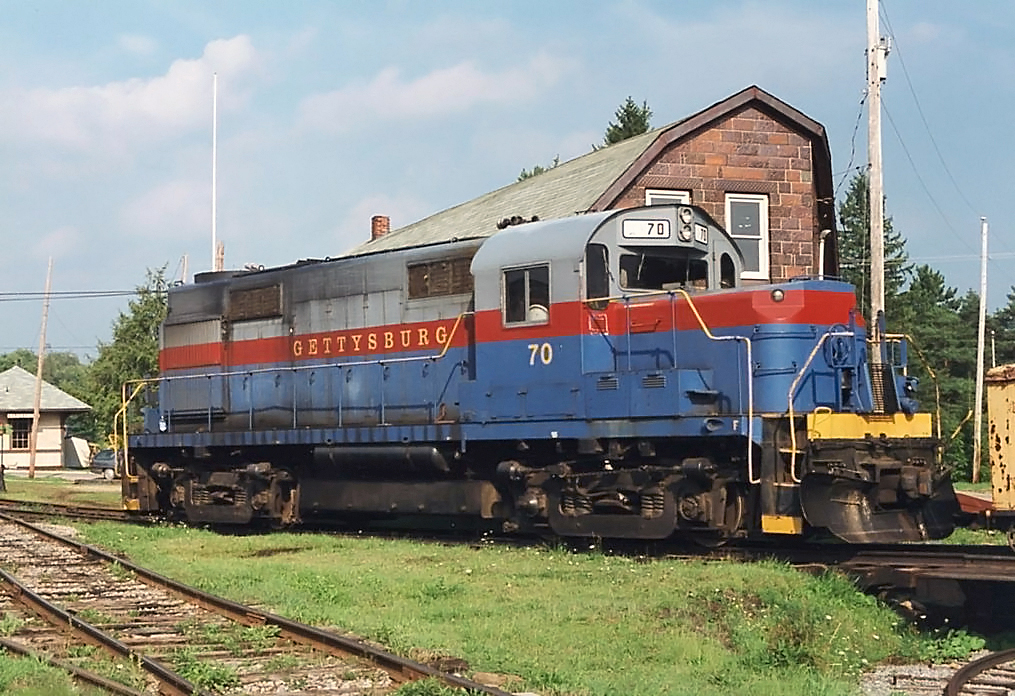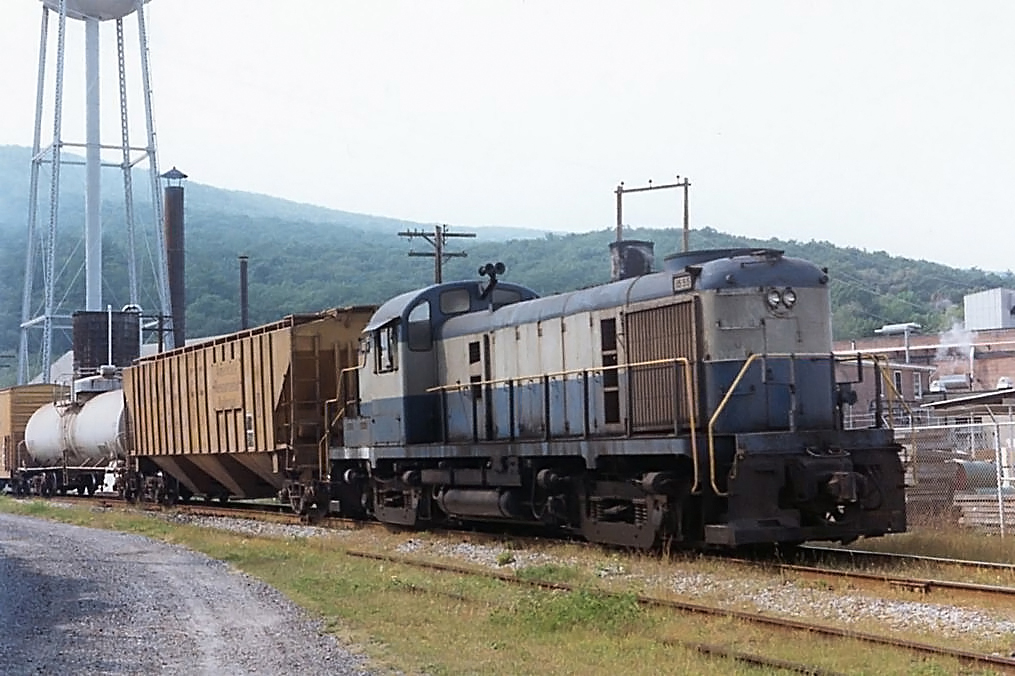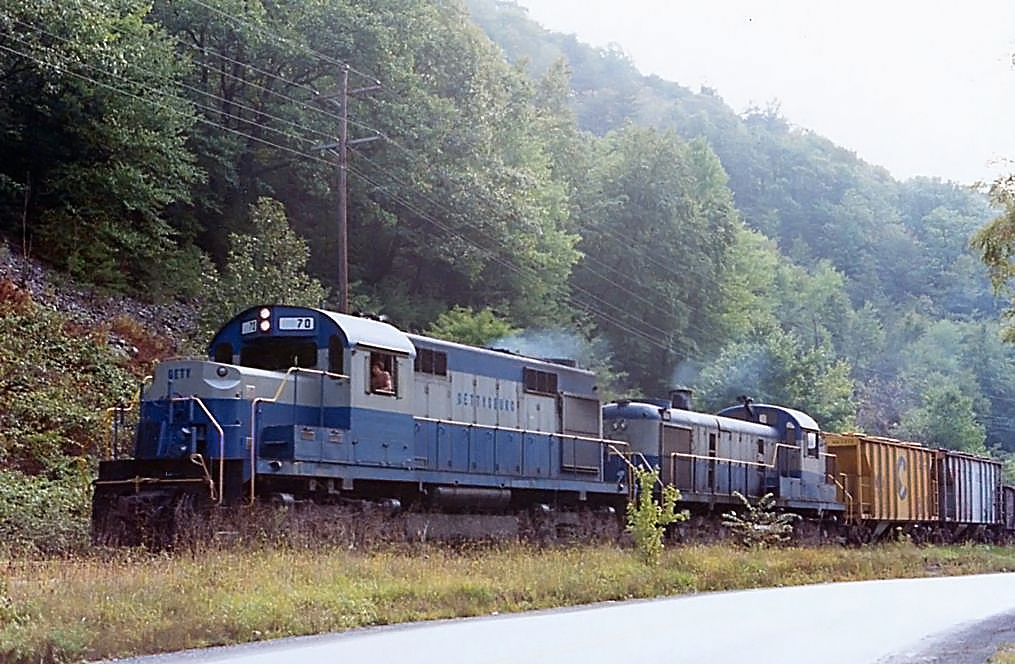Gettysburg Railroad (1976-1996): History, Roster, Photos
Published: July 22, 2024
By: Adam Burns
The Gettysburg Railroad, though short-lived, carved a unique niche in the annals of American rail history.
Operating from 1976 to 1996, this short line heritage railroad - operating 23.4-miles between Gettysburg and Mount Holly Springs - served not only as a transporter of goods but also as a living museum, enabling visitors to step back in time and experience the nostalgia of rail travel during a bygone era.
This comprehensive history dives into the origins, operations, challenges, and legacy of the Gettysburg Railroad, highlighting its significance within the broader spectrum of American heritage railroads.
 Gettysburg Railroad RS36 #70, wearing sister road Knox & Kane's livery, is seen here at Marienville, Pennsylvania on August 28, 1999. Doug Kroll photo.
Gettysburg Railroad RS36 #70, wearing sister road Knox & Kane's livery, is seen here at Marienville, Pennsylvania on August 28, 1999. Doug Kroll photo.Context and Background
The seeds of the Gettysburg Railroad were sown in the early 1970s when increasing competition from road transport and the decline in traditional rail freight started affecting many short line railroads across the United States.
The existing Gettysburg Branch of the Reading Railroad - which began as the Gettysburg and Harrisburg Railway of 1891 - was emblematic of this trend, facing the threat of abandonment due to diminished revenues and rising operational costs.
Founding Vision
In 1971 the Reading Railroad faced bankruptcy, a situation afflicting most northeastern systems of that era. Following Conrail's acquisition fo ths system in 1976 the branch line was not included in its network.
The Pennsylvania Department of Transportation quickly stepped in and acquird the Gettysburg Branch, transferring operations to the Blairsville & Indiana Railroad. Renamed the Gettysburg Railroad, this line continued its journey through time.
Operations
Freight operations began shortly after the formation of the company, with the line running from Gettysburg to Mount Holly Springs, Pennsylvania. Key commodities transported included agricultural products, lumber, and other light industrial goods.
The railroad played a crucial role in supporting local businesses by providing reliable and cost-effective freight services amidst an era of infrastructural shifts in American logistics.
Heritage and Excursion Services
Embracing its dual identity, by the late 1970s, the Gettysburg Railroad launched its heritage and excursion services.
The excursions typically featured vintage steam and diesel locomotives, with restored passenger cars that recreated the elegant atmosphere of early 20th-century rail travel.
These trips offered scenic journeys through the picturesque landscapes surrounding Gettysburg, often incorporating historical narratives and reenactments that paid homage to the region's Civil War heritage.
1. **Steam Locomotives**: The railroad operated notable steam engines such as the Gettysburg Railroad No. 76, a classic Baldwin 2-8-0 locomotive. These engines were often the centerpiece of the heritage experience, drawing rail enthusiasts eager to see and hear the sounds of a working steam locomotive.
2. **Themed Excursions**: Themed excursions, including Civil War reenactments, holiday specials, and murder mystery trains, became popular attractions that drew both locals and tourists.
These events not only provided entertainment but also educated the public about the historical significance of railroads in American society.
Economic Fluctuations and Adaptation
Throughout the 1980s and early 1990s, the Gettysburg Railroad faced various economic challenges, including the changing dynamics of regional industries and fluctuating tourist numbers.
To adapt, the railroad diversified its offerings and invested in marketing campaigns aimed at highlighting the unique blend of functional freight services and historical excursions.
 Gettysburg RS3 #1555 is seen here in freight service at Mt. Holly Springs, PA, September 22, 1980. Today the line is operated as the Gettysburg & Northern, a PatriotRail subsidiary. Doug Kroll photo.
Gettysburg RS3 #1555 is seen here in freight service at Mt. Holly Springs, PA, September 22, 1980. Today the line is operated as the Gettysburg & Northern, a PatriotRail subsidiary. Doug Kroll photo.Challenges and Tragic Incidents
Decline
By the early 1990s, the decline in traditional freight demand became more pronounced. Larger transportation networks and improved road infrastructure led many local businesses to switch to trucking for their logistic needs.
Despite efforts to attract new freight customers, the volume of transported goods dwindled, putting financial pressure on the railroad.
1995 Accident
The Gettysburg Railroad experienced a significant setback on June 16, 1995, when a steam locomotive, No. 1278, suffered a catastrophic boiler explosion during an excursion run.
The explosion, which occurred near Gardners, Pennsylvania, resulted in serious injuries to three crew members.
The incident was attributed to a failure in the boiler's crown sheet, exacerbated by poor maintenance conditions. This tragedy cast a long shadow over the railroad's operations and led to increased scrutiny from federal safety regulators.
Regulatory and Financial Consequences
In the wake of the accident, the Federal Railroad Administration (FRA) intensified inspections and imposed stringent safety requirements that necessitated significant investment in maintenance and upgrades.
The financial burden, combined with declining revenues, strained the railroad's resources. Attempts to secure additional funding and increase passenger numbers through enhanced marketing and special events were not sufficient to offset the rising operational costs.
Final Years
Attempts at Revitalization
In the mid-1990s, the Gettysburg Railroad undertook several initiatives aimed at revitalizing its operations.
Efforts included collaborations with local tourism boards, creating joint promotional packages with Gettysburg's historic sites, and exploring alternative revenue streams such as hosting private events and film shoots.
While these measures provided temporary boosts, they were not enough to ensure long-term sustainability.
Property Sale
By 1996, the cumulative financial strain, coupled with ongoing safety compliance issues and the legacy of the 1995 accident, made it increasingly untenable to continue operations.
Despite the dedication of its staff and the loyalty of rail enthusiasts, the Gettysburg Railroad ceased its excursions and freight services in late 1996. The cessation marked the end of a significant chapter in the preservation of American railway heritage.
In November, 1996, the Delaware Valley Railroad Company, a subsidiary of RailAmerica, acquired the property for $1,075,000. The new company breathed new life into the storied line by establishing the Gettysburg Railway, ensuring the legacy of these historic tracks endures.
Locomotive Roster
| Number | Wheel Arrangement/Model | Builder | Serial Number | Class | Railroad | Date Built | Years In Service |
|---|---|---|---|---|---|---|---|
| 3254 | 2-8-2 | Canadian Locomotive Company | 1463 | S-1-b | Canadian National | 1917 | 1982–1987 |
| 1278 | 4-6-2 | Canadian Locomotive Company | 2435 | G5d | Canadian Pacific | 1948 | 1987–1996 |
| 76 | 2-8-0 | Baldwin | 54265 | - | Mississippian Railway (built as Jonesboro, Lake City & Eastern #40) | 12/1920 | 1976–1996 |
| 38 | 2-8-0 | Baldwin | 59946 | - | Huntingdon & Broad Top Mountain Railroad | 4/1927 | 1977–1986 |
| 39 | GP9 | EMD | 23270 | - | Western Maryland | 4/1957 | 1989–1996 |
| 28 | U30B | GE | 36433 | - | Penn Central #2882 (built as New York Central #2882) | 11/1967 | 1985–1989 |
| 56 | RS3 | Alco | 81356 | - | Long Island Rail Road #1556 | 9/1955 | 1978–1988 |
| 70 | RS36 | Alco | 84101 | - | Norfolk & Western #2870 (built as Nickel Plate Road #870) | 6/1962 | 1985–1996 |
| 407 | S12 | Baldwin | 75838 | - | Monongahela #407 | 5/1953 | 1976–1985 |
 Gettysburg Railroad RS36 #70 and RS3 #1555 are northbound at Mt. Holly Springs, Pennsylvania on September 22, 1980. This 25 mile ex-Reading line was not picked up by Conrail in 1976. Doug Kroll photo.
Gettysburg Railroad RS36 #70 and RS3 #1555 are northbound at Mt. Holly Springs, Pennsylvania on September 22, 1980. This 25 mile ex-Reading line was not picked up by Conrail in 1976. Doug Kroll photo.Conclusion
The right-of-way was later to Pioneer RailCorp in 2001, who created the Gettysburg & Northern Railroad. Today, this system is a division of Patriot Rail.
The history of the Gettysburg Railroad is a testament to the enduring appeal and cultural significance of heritage railways in America.
Despite its relatively short lifespan, the railroad made a lasting impact through its dual mission of offering practical freight services and preserving the romance of vintage train travel.
Recent Articles
-
Indiana Valentine's Train Rides
Jan 12, 26 04:27 PM
If you’ve ever wished you could step into a time when passenger trains were a Saturday-night treat and a whistle echoing across farm fields meant “adventure,” the Nickel Plate Express delivers that fe… -
Ohio Valentine's Train Rides!
Jan 12, 26 04:20 PM
The Hocking Valley Scenic Railway offers one of the region’s most atmospheric ways to experience the Hocking Hills area: from the rhythmic click of jointed rail to the glow of vintage coaches rolling… -
Wisconsin's - Wine Tasting - Train Rides
Jan 12, 26 03:10 PM
Wisconsin might not be the first state that comes to mind when one thinks of wine, but this scenic region is increasingly gaining recognition for its unique offerings in viticulture. -
California's - Wine Tasting - Train Rides
Jan 12, 26 02:34 PM
This article explores the charm, routes, and offerings of these unique wine tasting trains that traverse California’s picturesque landscapes. -
Wisconsin Scenic Train Rides In North Freedom!
Jan 12, 26 02:20 PM
The Mid-Continent Railway Museum is a living-history museum built around the sights, sounds, and everyday rhythms of small-town and shortline railroading in the early 20th century, what the museum cal… -
Vermont Scenic Train Rides In Burlington!
Jan 12, 26 01:18 PM
Today, GMRC is best known by many travelers for its Burlington-based passenger experiences—most famously the Champlain Valley Dinner Train and the sleek, limited-capacity Cocktails on the Rails. -
Maryland's - Murder Mystery - Dinner Train Rides
Jan 12, 26 01:03 PM
Maryland is known for its scenic landscapes, historical landmarks, and vibrant culture, but did you know that it’s also home to some of the most thrilling murder mystery dinner trains? -
Minnesota's - Murder Mystery - Dinner Train Rides
Jan 12, 26 12:17 PM
Murder mystery dinner trains offer an enticing blend of suspense, culinary delight, and perpetual motion, where passengers become both detectives and dining companions on an unforgettable journey. -
Vermont Dinner Train Rides In Burlington!
Jan 12, 26 12:09 PM
There is one location in Vermont hosting a dedicated dinner train experience at the Green Mountain Railroad. -
Connecticut Dinner Train Rides In Essex!
Jan 12, 26 10:39 AM
Connecticut's rail heritage can be traced back to the industry's earliest days and a few organizations preserve this rich history by offering train rides. The Essex Steam Train also hosts dinner-theme… -
Florida Scenic Train Rides In Parrish!
Jan 11, 26 10:26 PM
The Florida Railroad Museum (FRRM) in Parrish offers something increasingly rare in today’s rail landscape: a chance to ride historic equipment over a surviving fragment of an early-20th-century mainl… -
California's - Wine Tasting - Train Rides
Jan 11, 26 02:28 PM
This article explores the charm, routes, and offerings of these unique wine tasting trains that traverse California’s picturesque landscapes. -
Georgia's - Murder Mystery - Dinner Train Rides
Jan 11, 26 02:07 PM
In the heart of the Peach State, a unique form of entertainment combines the thrill of a murder mystery with the charm of a historic train ride. -
Colorado ~ Murder Mystery ~ Dinner Train Rides
Jan 11, 26 01:43 PM
Nestled among the breathtaking vistas and rugged terrains of Colorado lies a unique fusion of theater, gastronomy, and travel—a murder mystery dinner train ride. -
Minnesota Dinner Train Rides In Duluth!
Jan 11, 26 01:32 PM
One of the best ways to feel the region's history in motion today is aboard the North Shore Scenic Railroad (NSSR), which operates out of Duluth’s historic depot. -
Illinois Dinner Train Rides At Monticello!
Jan 11, 26 12:42 PM
The Monticello Railway Museum (MRM) is one of those places that quietly does a lot: it preserves a sizable collection, maintains its own operating railroad, and—most importantly for visitors—puts hist… -
Alabama's - Wine Tasting - Train Rides
Jan 10, 26 09:29 AM
While the state might not be the first to come to mind when one thinks of wine or train travel, the unique concept of wine tasting trains adds a refreshing twist to the Alabama tourism scene. -
Maryland Dinner Train Rides At WMSR!
Jan 10, 26 09:13 AM
The Western Maryland Scenic Railroad (WMSR) has become one of the Mid-Atlantic’s signature heritage operations—equal parts mountain railroad, living museum, and “special-occasion” night out. -
Arkansas Dinner Train Rides On The A&M!
Jan 10, 26 09:11 AM
If you want a railroad experience that feels equal parts “working short line” and “time machine,” the Arkansas & Missouri Railroad (A&M) delivers in a way few modern operations can. -
South Dakota's - Murder Mystery - Dinner Train Rides
Jan 10, 26 09:08 AM
While the state currently does not offer any murder mystery dinner train rides, the popular "1880 Train" at the Black Hills Central recently hosted these popular trips!



















